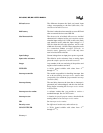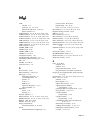
8XC196MC, MD, MH USER’S MANUAL
Glossary-10
special interrupt Any of the three nonmaskable interrupts (unimple-
mented opcode, software trap, or NMI).
special-purpose memory A partition of memory used for storing the interrupt
vectors, PTS vectors, chip configuration bytes, and
several reserved locations.
standard interrupt Any maskable interrupt that is assigned to the
interrupt controller for processing by an interrupt
service routine.
state time (or state) The basic time unit of the device; the combined
period of the two internal timing signals, PH1 and
PH2. (The internal clock generator produces PH1 and
PH2 by halving the frequency of the signal on
XTAL1. The rising edges of the active-high PH1 and
PH2 signals generate CLKOUT, the output of the
internal clock generator.) Because the device can
operate at many frequencies, this manual defines time
requirements in terms of state times rather than in
specific units of time.
successive approximation An A/D conversion method that uses a binary search
to arrive at the best digital representation of an analog
input.
temperature coefficient Change in the stated variable for each degree
Centigrade of temperature change.
temperature drift The change in a specification due to a change in
temperature. Temperature drift can be calculated by
using the temperature coefficient for the specification.
terminal-based characteristic An actual characteristic that has been translated and
scaled to remove zero-offset error and full-scale error.
A terminal-based characteristic resembles an actual
characteristic with zero-offset error and full-scale
error removed.
transfer function A graph of output code versus input voltage; the
characteristic of the A/D converter.


















